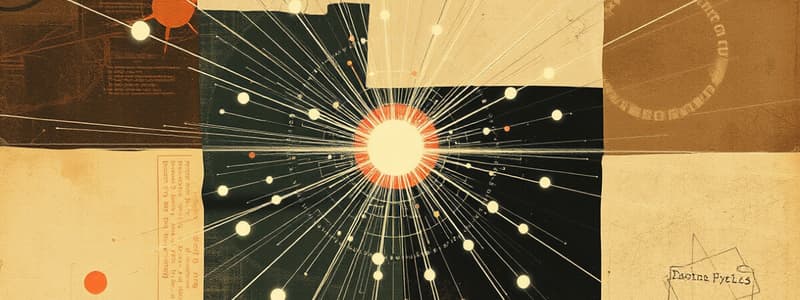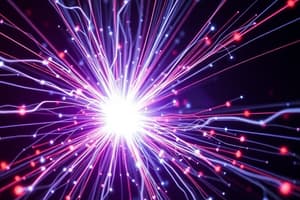Podcast
Questions and Answers
What is the most direct evidence that light comes in quanta?
What is the most direct evidence that light comes in quanta?
The photoelectric effect
What is the photoelectric effect?
What is the photoelectric effect?
The emission of electrons from a metallic surface when electromagnetic radiation of a high enough frequency is incident on it.
What is a photon?
What is a photon?
The smallest unit of light or other electromagnetic energy, having no mass and no electric charge.
What is the formula to find the energy in a photon?
What is the formula to find the energy in a photon?
In the formula E = hf, what does the f stand for?
In the formula E = hf, what does the f stand for?
In the formula E = hf, what does the h stand for?
In the formula E = hf, what does the h stand for?
What is the size of the Planck constant?
What is the size of the Planck constant?
How much of the photon energy is given to the electron?
How much of the photon energy is given to the electron?
What is the minimum amount of energy that is required by the electron to remove it from the metal?
What is the minimum amount of energy that is required by the electron to remove it from the metal?
What happens if a photon contains less energy than the work function?
What happens if a photon contains less energy than the work function?
What happens if a photon contains more energy than the work function?
What happens if a photon contains more energy than the work function?
What happens if a photon contains the same energy as the work function?
What happens if a photon contains the same energy as the work function?
What is the threshold frequency?
What is the threshold frequency?
What is the wavelength called that corresponds to the threshold frequency?
What is the wavelength called that corresponds to the threshold frequency?
Flashcards are hidden until you start studying
Study Notes
Photoelectric Effect Overview
- The photoelectric effect serves as direct evidence that light exists in quantized packets, known as photons.
- It involves the emission of electrons from a metal surface when electromagnetic radiation of sufficient frequency strikes it.
Photons
- Photons are the smallest discrete units of light and electromagnetic energy, possessing no mass or electric charge.
- They exhibit dual characteristics, behaving both as particles and waves.
Energy of a Photon
- The energy of a photon is calculated using the formula E = hf, where:
- E represents energy.
- h is the Planck constant.
- f is the frequency of the radiation, measured in Hertz (Hz).
Planck Constant
- The Planck constant (h) is valued at 6.63 x 10⁻³⁴ Joule-seconds (Js).
Electron Interaction with Photons
- When a photon impacts a metal, the entire energy of the photon is transferred to the electron.
- The minimum energy requirement to eject an electron from a metal is termed the work function (ϕ).
- If a photon has less energy than the work function, no electrons will be emitted from the metal.
- If a photon carries more energy than the work function, electrons are emitted, and the surplus energy converts into the electron's kinetic energy.
- When a photon matches the energy of the work function exactly, electrons are emitted without any available energy for further kinetic motion.
Frequency and Wavelength Considerations
- The threshold frequency is the minimum frequency required for the emission of an electron.
- The corresponding wavelength for this threshold frequency is called the cutoff wavelength, indicating the upper limit beyond which electron emission ceases.
Studying That Suits You
Use AI to generate personalized quizzes and flashcards to suit your learning preferences.




